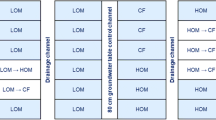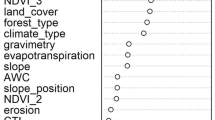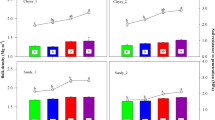Abstract
Aims
Most cereals accumulate Si in their shoots. Soil bioavailability of Si may be a constraint on the beneficial role of silica in cereals but it is not yet well supported by field data. The aim of this study is to evaluate the long-term impact of wheat straw exports on the pool of soil phytoliths, which, it is suggested, represents the most labile and renewable pool of soil Si.
Methods
We measured the amorphous Si (ASi) in soils from several experiments at Rothamsted Research (UK), which provided long-term soil data back to the middle of the 19th century, using two alternative extraction techniques: Na2CO3 (referred to as ASnc) or zinc bromide extraction (referred to as ASizb).
Results
All samples showed a similar range of ASnc and ASizb but low values (0.1–3.4 mg g−1 DW) compared to published data on natural ecosystems. In the Broadbalk experiment, a decrease over time in ASi in the topsoil samples is in good agreement with the hypothesis that cropping and exports of straw leads to depletion of soil phytoliths. A decrease in Si concentration in straw samples was observed between 1883 and 1944. From 1944 to the present, Si concentration increased irregularly in the straw, probably as the result of liming, which enhanced the dissolution of the remaining phytoliths through increasing pH. In the reforested Geescroft field the higher phytolith concentration in the modern topsoil samples is in good agreement with a re-building of phytolith storage from litter input in an acidic environment.
Conclusions
Our results therefore support the hypothesis that export of wheat straw leads to a decrease in bioavailable Si.






Similar content being viewed by others
References
Alexandre A, Meunier JD, Lezine AM, Vincens A, Schwartz D (1997) Phytoliths: indicators of grassland dynamics during the late Holocene in intertropical Africa. Pal Pal Pal 136:213–229
Alexandre A, Meunier JD, Mariotti A, Soubies F (1999) Late Holocene phytolith and carbon-isotope record from a latosol at Salitre, south-central Brazil. Quat Res 51:187–194
Avery BW, Catt JA (1995) The soil at Rothamsted. Lawes Agricultural Trust, Harpenden, Herts
ADEME/ITCF (1998) Blé plante entière. Etude Agrice. 4p
Bartoli F (1981) Le cycle biogéochimique du silicium sur roche acide. Application à deux écosystèmes forestiers tempérés (Vosges). PhD Thesis, University of Nancy I.
Biermans V, Baert L (1977) Selective extraction of amorphous Al, Fe and Si oxides using an alkaline Tiron solution. Clay Minerals 12:127–135
Brenchley WE, Maskell EJ (1927) The inter-relation between silicon and other elements in plant nutrition. Annals Appl Biol XIV(1):45–82
Cheng BT (1982) Some significant functions of silicon to higher-plants. J Plant Nutr 5:1345–1353
Datnoff LE, Snyder GH, Korndorfer GH (eds) (2001) Silicon in agriculture. Studies in Plant Science 8. Elsevier.
DeMaster DJ (1981) The supply and accumulation of silica in the marine environment. Geochim Cosmochim Acta 45:1715–1732
Desplanques V, Cary L, Mouret JC, Trolard F, Bourrié G, Grauby O, Meunier JD (2006) Silicon transfers in a rice field in Camargue (France). J Geochem Explor 88:190–193
Ding TP, Ma GR, Shui MX, Wan DF, Li RH (2005) Silicon isotope study on rice plants from the Zhejiang province, China. Chem Geol 218:41–50
Epstein E (1999) Silicon. Ann Rev Plant Physiol Plant Molec Biol 50:641–664
Fishkis O, Ingwersen J, Lamers M, Denysenko D, Streck T (2010a) Phytolith transport in soil: a laboratory study on intact soil cores. Eur J Soil Sci 61:445–455
Fishkis O, Ingwersen J, Lamers M, Denysenko D, Streck T (2010b) Phytolith transport in soil: A field study using fluorescent labelling. Geoderma 157:27–36
Fraysse F, Pokrovsky OS, Schott J, Meunier JD (2006) Surface properties, solubility and dissolution kinetics of bamboo phytoliths. Geochim Cosmochim Acta 70:1939–1951
Fraysse F, Pokrovsky OS, Schott J, Meunier JD (2009) Surface chemistry and reactivity of plant phytoliths in aqueous solutions. Chem Geol 258:197–206
Guntzer F, Keller C, Meunier JD (2010) Determination of the silicon concentration in plant material using Tiron extraction. New Phyt 188:902–906
Heaney PJ, Prewitt CT, Gibbs GV (eds) (1994) Silica: physical behavior, geochemistry and materials applications. Reviews in mineralogy 29, Mineralogical Society of America.
Henriet C, Bodarwe L, Dorel M, Draye X, Delvaux B (2008) Leaf silicon content in banana (Musa spp.) reveals the weathering stage of volcanic ash soils in Guadeloupe. Plant Soil 313:71–82
Hodson MJ, White PJ, Mead A, Broadley MR (2005) Phylogenetic variation in the silicon composition of plants. Ann Bot 96:1027–1046
Jones LHP, Handreck KA (1965) Studies of silica in the oat plant. Plant Soil 23:79–96
Jones LHP, Handreck KA (1967) Silica in soils, plants, and animals. Adv Agron 19:104–149
Kelly EF (1990) Methods for extracting opal phytoliths from soil and plant material. Workshop on biotic indicators of global change, University of Washington (Seattle)
Lawes JB, Gilbert JH (1864) Report of experiments on the growth of wheat for twenty years in succession on the same land. London: printed by W. Clowes and Sons. 1864. First Edition, 109 pp
Ma JF, Takahashi E (2002) Soil, fertilizer and plant silicon research in Japan. Elsevier
Makabe S, Kakuda K, Sasaki Y, Ando T, Fujii H, Ando H (2009) Relationship between mineral composition or soil texture and available silicon in alluvial paddy soils on the Shounai Plain, Japan. Soil Sci Plant Nutr 55:300–308
Piperno DR (1987) Phytolith analysis. An Archaeological and Geological Perspective. Academic Press
Poulton PR, Pye E, Hargreaves PR, Jenkinson DS (2003) Accumulation of carbon and nitrogen by old arable land reverting to woodland. Global Change Biol 9:942–955
Rodgers-Gray BS, Shaw MW (2004) Effects of straw and silicon soil amendments on some foliar and stem-base diseases in pot-grown winter wheat. Plant Pathol 53:733–740
Rothamsted Research (2006) Guide to the classical ad other long-term experiments, datasets and sample archive. Lawes Agricultural Trust Co. Ltd
Saccone L, Conley DJ, Koning E, Sauer D, Sommer M, Kaczorek D, Blecker SW, Kelly EF (2007) Assessing the extraction and quantification of amorphous silica in soils of forest and grassland ecosystems. Eur J Soil Sci 58:1446–1459
Saccone L, Conley DJ, Likens GE, Bailey SW, Buso DC, Jonhson CE (2008) Factors that control the range and variability of amorphous silica in soils in the hubbard brook experimental forest. Soil Sci Soc Am J 72:1637–1644
Sangster AG, Hodson MJ, Tubb HJ (2001) Silicon deposition in higher plants. In: Datnoff LE. Snyder GH, Korndorfer GH (eds.), Silicon in agriculture. Studies in Plant Science 8. Elsevier, pp. 85–113.
Savant NK, Datnoff LE, Snyder GH (1997a) Depletion of plant-available silicon in soils: a possible cause of declining rice yields. Commun Soil Sci Plant Anal 28:1245–1252
Savant NK, Snyder GH, Datnoff LE (1997b) Silicon management and sustainable rice production. Adv Agron 58:151–199
Sommer M, Kaczorek D, Kuzyakov Y, Breuer J (2006) Silicon pools and fluxes in soils and landscapes—a review. J Plant Nutr Soil Sci 169:310–329
Tuna AL, Kaya C, Higgs D, Murillo-Amador B, Aydemir S, Girgin AR (2008) Silicon improves salinity tolerance in wheat plants. Environ Exp Botany 62:10–16
White AF, Brantley SL (eds) (1995) Chemical weathering rates of silicate minerals. Reviews in Mineralogy 31, Mineralogical Society of America.
Acknowledgments
This work has been financed by EC2CO, a French national scientific program of CNRS (INSU). Rothamsted Research receives grant-aided support from the Biotechnology and Biological Sciences Research Council (BBSRC) of the United Kingdom. We thank Muhammad Rizwan for his help in extracting ASinc.
Author information
Authors and Affiliations
Corresponding authors
Additional information
Responsible Editor: Jian Feng Ma.
Rights and permissions
About this article
Cite this article
Guntzer, F., Keller, C., Poulton, P.R. et al. Long-term removal of wheat straw decreases soil amorphous silica at Broadbalk, Rothamsted. Plant Soil 352, 173–184 (2012). https://doi.org/10.1007/s11104-011-0987-4
Received:
Accepted:
Published:
Issue Date:
DOI: https://doi.org/10.1007/s11104-011-0987-4




